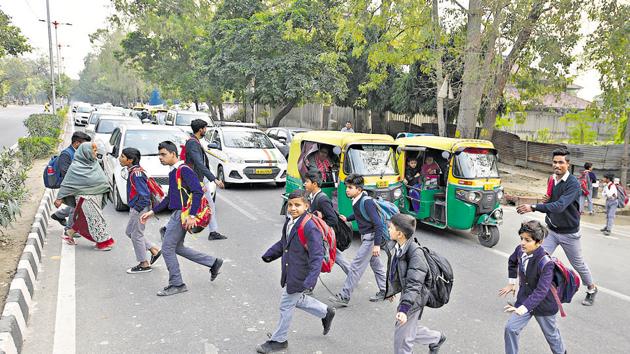Haryana cannot afford to lose any more pedestrian lives on its roads
Why is it so dangerous to walk on the streets in Haryana, and especially in Gurugram? The reasons are threefold.
The latest road accident report by the Ministry of Road Transport & Highways (MoRT&H) indicates that India is not a country for pedestrians. Last year, around 22,565 pedestrians were killed in road accidents. A total of 12,330 pedestrians lost their lives in 2014—that’s a whopping 84% increase in pedestrian deaths; that too in a relatively short span of just five years. The report reveals that more than 1.51 lakh lives were lost in 2018 on Indian roads, which is about 0.5% more than the 2017 figures. Thus making Indian roads the most dangerous of all the 199 countries in the world. Vulnerable road users, comprising pedestrians, cyclists, and two-wheelers, formed a little more than half (54%) of all fatalities. However, the worst impacted were pedestrians.

As per the report, 5,118 people lost their lives in Haryana, of which 29% were pedestrians. West Bengal, Maharashtra, and Andhra Pradesh were the top three states in terms of the total number of pedestrian death, but they are also large states. However, data measured in terms of pedestrian death per lakh reveals that Haryana is the worst-performing state in the country. As per the data, West Bengal, Maharashtra, and Andhra Pradesh recorded 2.9, 2.1 and 2.4 pedestrian fatalities per lakh, respectively. The number in Haryana is 5.8, which is more than double of West Bengal. That’s not all; Gurugram is the worst-performing district in Haryana with 202 pedestrian deaths in 2018.
So why it is so dangerous to walk on the streets in Haryana, and especially in Gurugram? Let me highlight three significant problems.
Speeding
The MoRT&H report indicates that speeding accounted for 64.4% of total road fatalities in the country. Research shows that if a car hits a pedestrian at 30 kmph, the chances of the victim’s survival are 90%. But if it hits a person at 50 kmph, which is the legal speed limit on most roads, the survival chance is less than 30%. Pedestrian survival chances are almost zero if the collision takes place at 80 kmph. A 2014 study by WRI India for Netaji Subhash Marg between Huda City Center and Subhash Chowk found that during the peak hour, the average speed of most vehicles was 30% more than the speed limit of 50 kmph. During off-peak hours, the speed of most vehicles was over 100 kmph. It’s not hard to imagine what could happen if a pedestrian were to be hit by one of these vehicles. Therefore, it is vital to manage speed because, for every 1km in speed reduction, there is a 2% to 3% reduction in accidents.
Wrong design
Design directly impacts safety. It may sound simple, but it’s the least understood concept, at least in terms of roads. Most roads in our cities are designed like highways. Highways are designed to move goods and people from one town to another and are to be used by motor vehicles. Urban roads, on the other hand, have multiple users, including motorised as well as non-motorised users such as pedestrians and cyclists. Since urban streets are not designed correctly, the safety of pedestrians is compromised. Golf Course Road is a classic example of what’s wrong with the city’s road design. An urban road passing through the heart of the city has 16 lanes for cars, which in any case, is not needed. Still, it does not have even 16 inches of footpath. In fact, most roads in Gurugram don’t have proper footpaths and wherever present, they are either encroached upon by parked vehicles or utilities. An unobstructed footpath on all streets is a prerequisite for pedestrian safety.
Unsafe intersections
Research shows that the bulk of pedestrian deaths happen while they are crossing the road. Rajiv Chowk, the Khandsa exit, and the Narsingpur exit in Gurugram are first-order ‘blackspots’ and are all intersections. That’s why the management of traffic intersection plays a vital role in safety. Unfortunately, when it comes to pedestrian crossing, the conversation shifts to foot overbridges or underpasses. It is complete nonsense because pedestrians are like water; they tend to find the shortest route to cross. Will water go up and down to cross a road? Surely not. Then why do we expect pedestrians to use foot overbridges and underpasses to cross roads? Yes, there may be a high-speed road that may warrant a grade-separated facility, but that should be an exception and not the rule. Also, the business of closing down intersections for ‘u-turns’ needs to end immediately. We need to develop pedestrian crossing facilities that are intuitive for people to access.
Therefore, Haryana cannot afford to lose any more pedestrian lives on its roads. The state government’s Haryana Vision Zero programme is an important initiative for improving road safety. All it needs is to reignite its ambition with a focus on pedestrian safety.
@amitbhatt4u
(Amit Bhatt is director, integrated transport at WRI)




